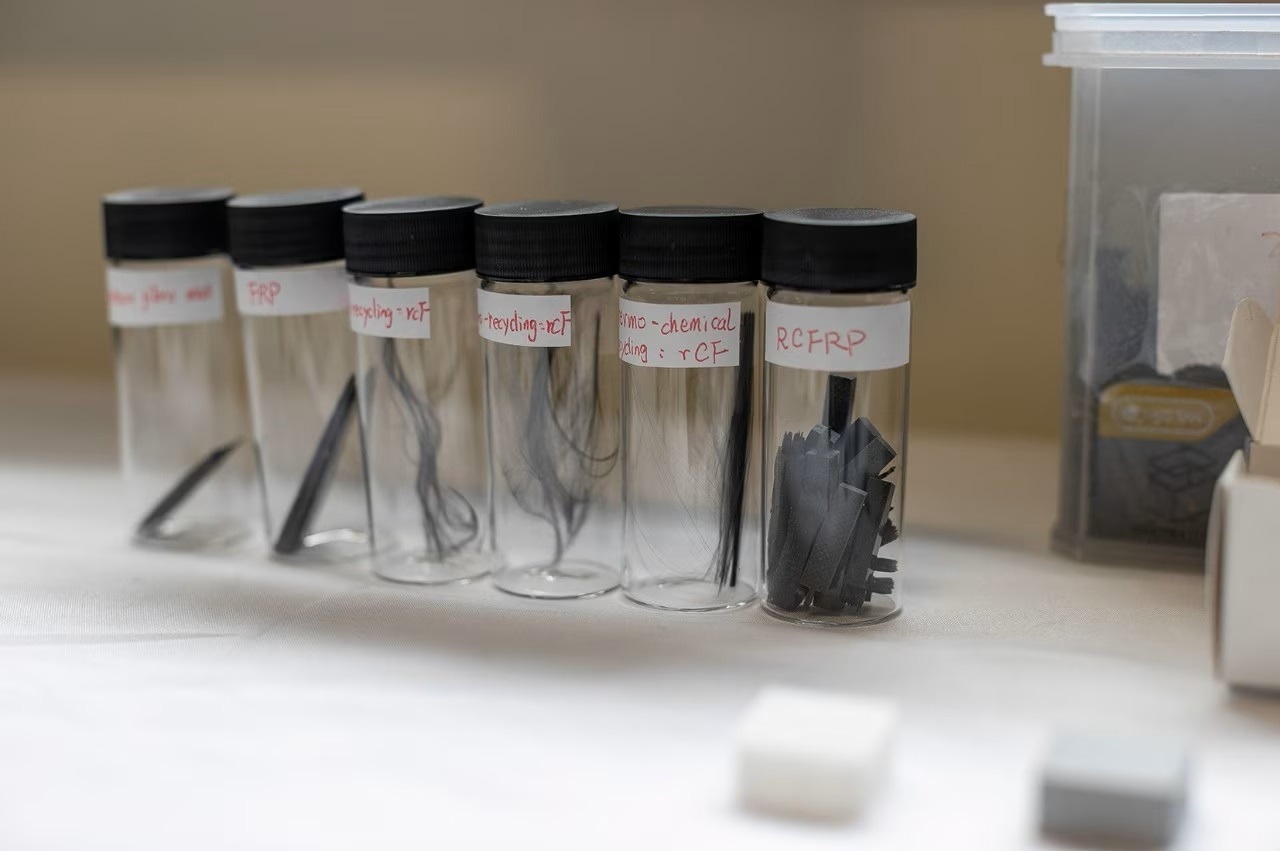The University of Sydney scientists have developed new approaches for addressing a significant source of future waste from the automotive, aerospace, and renewable industries.
 Recycled product. Image Credit: Stefanie Zingsheim, University of Sydney.
Recycled product. Image Credit: Stefanie Zingsheim, University of Sydney.
Carbon and glass fiber composites (CFRP), frequently used in wind turbine blades, aircrafts, yachts, hydrogen tanks, construction, and car manufacturing, are expected to be a major waste stream by 2030.
If appropriate recycling methods are not implemented, the annual accumulation of CFRP waste from the aircraft and wind turbine industries alone is expected to reach 840,300 tons by 2050—the equivalent of 34 full stadiums.
While recycling methods exist, most of this waste is currently disposed of in landfills or incinerated. Producing “virgin” composites has additional environmental implications, such as resource depletion and high energy input during production, despite the presence of numerous methods for recycling carbon fiber composites, which, according to a research group at the University of Sydney, have the greatest potential to reduce energy use by 70% and inhibit key materials from going to waste if implemented properly.
Carbon fiber composites are considered a ‘wonder’ material—they are durable, resistant to weathering, and highly versatile—so much so that their use is projected to increase by at least 60 percent in the next decade alone. But this huge growth also brings a huge increase in waste. For instance, it's been estimated that around 500,000 tons of carbon and glass fiber composite waste from the renewable energy sector will exist by 2030.
Dr. S. A. Hadigheh, School of Civil Engineering, The University of Sydney
A New Recycling Method
To address this issue, Dr. Hadigheh and his recent Ph.D. graduate Dr. Yaning Wei created a new recycling method for carbon and glass fiber composites to keep end-of-life materials out of landfills. Their approach, which was published in Composites Part B: Engineering, guarantees increased material recovery and improved energy efficiency when compared to the previous methods.
Our kinetic analysis revealed that pre-treated CFRP undergoes an additional reaction stage, enabling enhanced breakdown at lower temperatures compared to untreated CFRP. The solvolysis pre-treatment not only facilitates greater breakdown but also preserves the mechanical properties of fibers by reducing heat consumption during recycling.
Dr. S. A. Hadigheh, School of Civil Engineering, The University of Sydney
Recycled fibers derived from pre-treated CFRP retained up to 90% of their original strength, outperforming fibers recovered solely through thermal degradation by 10%.
“To demonstrate the real-world applicability of our method, we successfully recycled part of a bicycle frame and airplane scraps made of CFRP composites using our hybrid approach. These results not only validate the effectiveness of chemical pre-treatment but also demonstrate the improved mechanical characteristics of the recycled carbon fibers,” adds Dr Hadigheh.
Reclaiming Carbon Fiber
The group previously provided a detailed evaluation of 10 different carbon and glass fiber composite waste treatment systems driven by economic efficiency and environmental effects, taking into account the type of waste material and its geographical location.
Dr. Hadigheh’s group found that solvolysis—a method of breaking down materials with a solvent application at a particular pressure and temperature—could reclaim carbon fiber while delivering a high net profit. Thermal recycling methods like catalytic pyrolysis and pyrolysis with oxidation also provided a high economic return.
Solvolysis and electrochemical methods have also been shown to emit significantly less CO2 into the atmosphere than landfilling and incineration.
A Huge Opportunity
According to the investigators, manufacturers should look beyond continuously producing virgin material and instead establish recycled products from end-of-life streams.
“This is a huge opportunity. And not only because various modes of recycling are cost-effective and minimally impactful on the environment. In an era of mounting supply chain disruptions, local recycled products can provide a more immediate product when compared to imports and create a burgeoning advanced manufacturing industry,” states said Dr. Wei.
While awareness of everyday consumer recycling is increasing and plastic waste is in the spotlight, Australia must urgently consider wide-scale recycling of new generation construction materials before they mount up as another waste problem and are put into the ‘too hard basket.’
Dr. Yaning Wei, Ph.D. Graduate, The University of Sydney
Dr. Hadigheh’s team is also working on ways to recycle composite materials, and they lately patented a machine that accurately aligns recycled carbon fibers so that they can be reused.
Journal Reference:
Wei, Y., & S.A. Hadigheh. (2023). Development of an innovative hybrid thermo-chemical recycling method for CFRP waste recovery. Composites Part B: Engineering. doi.org/10.1016/j.compositesb.2023.110786.